How well do you really know your customers?
Imagine your business has just released a new set of products that you’re selling through your storefront and online. You notice the amount of sales through both are pretty evenly distributed, yet the customers who are buying in-person seem way more satisfied with the same exact product than those who found you online. Why is this?
Of course, there’s going to be an aspect of trial and error in any growing business as you learn through the evolution of your products and services. Still, for a business to run efficiently, you need to be able to remove as much guesswork as possible.
How do you do that?
By understanding the full journey in which a customer or prospect finds you, chooses you, and engages with you.
In other words, you need to fully understand your customer journey.
As a company that specializes in connecting businesses with customers through seamless communication tools, we focus on enabling great customer experiences, which is an approach any great business should share. But don’t just take it from us. Take it from some of the most powerful business leaders today, such as Ann Lewnes, EVP and CMO of Adobe, who says that “the term ‘customer experience’ won’t exist in the organization of the future. It will be so deeply entrenched in a company’s product, process, and culture that it will be synonymous with the brand and represent the only way to do business.”1
In other words, it’s not just smart businesses that are putting customer journeys on the radar, it’s every business that’s keeping pace with their competition.
In this post, we’ll cover:
🤝 Want to create your own customer journey map? Download the free template to help you get started:
What is a “customer journey”?
A customer journey, or more specifically, a customer journey map, is a visual tool that maps the steps a customer has with a business. Though the scope can vary, an end-to-end journey might map out the first moment that someone becomes aware of your business, to the point where they’ve bought in, to where they’re actively using your products/services, to (ideally) becoming an advocate for it.
Sometimes it’s linear, sometimes it’s cyclical (like when you upsell or cross-sell someone, get them onto a new product, and the steps begin again).
Customer journeys help you achieve the wider goal of improving your overall customer experience.
While a customer “experience” happens during a moment of interaction, the journey is the story that stitches all these individual experiences together into a collection.
More than that, the journey considers those sets of experiences across a collection of touchpoints. Meaning, if people find your website through your Instagram and reach out to you by email to finally connect one on one with a sales rep, then the customer journey captures four individual touchpoints where engagement happens: your social channel, website, email, and sales team.
To put it directly, an experience is a moment; the journey is the story.
To improve your customer experience, you need to be able to zoom out and understand the wider story that’s happening across time. Time is an important element of a customer journey because people have different needs and expectations at different points in their buying process. You can’t delight a customer without understanding their mindset at each individual point in time.
Before we get into how exactly you can build a customer journey framework, it helps to understand why we’re building them to begin with.
[ebook-download title=”How customer-obsessed is your business?” link=”https://netstorage.ringcentral.com/documents/quiz_how_customer_obsessed_your_business.pdf” cta-text=”Take the quiz” src=””]
The benefits of knowing your customer journey
Before someone becomes a customer, there are so many small decisions along the way that get made. When you know the forces that affect these decisions, then you have the power to influence them towards your direction.
We all know that information is power. In this case, information about the journey your customer takes to reach and engage with you is going to help you optimize your sales and marketing strategies. Here are some direct ways of how this happens:
1) Know when and where to support: Throughout the process of your customer becoming aware of you to when they finally buy from you, more often than not, there are moments along the way where extra support could benefit them. Whether that’s being unsure how to navigate to what they need or needing help with a return in store without a receipt, these are all situations that can be alleviated with the right customer support. Recognizing that it’s simply not possible to have someone available 24/7 to answer customer questions, you might decide to have an FAQ page so that customers can help themselves anytime.
2) Target who to reach better: Even though digital marketing allows you to reach an abundance of people instantly, that doesn’t mean you should reach an abundance of people instantly. The “wide-net” technique of casting far and seeing which customers stick isn’t always effective—and can drive up customer acquisition costs. You want customers who are a good fit for your product and will actually stay long term. If you sell to just anyone and they end up leaving within a few weeks anyway, you’re wasting your own resources (and your salespeople’s time).
3) Create highly personalized experiences: Before a customer reaches you directly, chances are they’ve already come across you in other ways such as through your site, a review, or an ad. Having the ability to see the customer as the same person at different moments in time, rather than as three separate people will allow you to leverage each interaction to learn more about the customer overtime. With a record of past conversations and interactions with your customer across different touchpoints, you can use this information to tailor your products or services to them (like through targeted ads), or create experiences individualized for them (like knowing what other products or services to recommend).
This is where it’s useful to have some kind of social CRM or contact center solution that can consolidate all those conversations across your social media channels, emails, and messages in one place. Like RingCentral Engage Digital™, for instance:
The 4 stages of the customer journey
Like any other journeys that come to mind, customer journeys have a beginning, middle, and end. In the context of business, it refers to the moments before, during and after a customer makes a purchase.
The lifecycle of the customer consists of 4 phases:
Phase 1: Awareness
The prospect has a problem they need solving and starts looking for the right product or service. They begin a search for the solution and become aware of your business for the first time.
Example: “I need to create a new website. I might be able to do it myself, but I think it might be easier if I use a website builder. Let me Google “affordable website builder.”
Phase 2: Explore
The prospect explores their options and gathers more information, comparing different providers and evaluating the pros and cons between them.
Example: “It looks like I could try using Squarespace, Wix, or Shopify. But eventually, I’d probably need to sell clothing through my site so maybe one that can support e-commerce is better for me… let me explore the Features page of each site and check out what their users are saying.”
Phase 3: Purchase
After consideration, the prospect decides to purchase your product/service and becomes a customer. They gain value from the purchase.
Example: “I can’t find my wallet… oh wait, they have PayPal! Looks like I can log in and start using site templates right away!”
Phase 4: Retention
The customer is satisfied from the initial purchase and feels loyal towards the business. They show support by either recommending the product or service to others, or even by sharing positive feedback.
Example: “Wow that took less time than I waste in a single meeting… Incredible. I know a few people who might be interested in this, I think I’ll share my referral code with them!”
Being proactive in your customer service (such as by anticipating issues before they arise) isn’t just a great way to decrease customer calls, it also drives loyalty and can improve your customer retention.
How to build a customer journey map
Step 0: Answer the “What will this do?”
When building a customer journey framework for the first time, you need to identify what problems you want to be solving with it.
For instance, if you’re trying to look for ways in which you’re making things inconvenient for your customers, then your aim could be to explore all the touchpoints you have in the experience and correct their moments of frustration. Equipped with this knowledge, you can then better direct your team’s efforts more efficiently to solve this problem.
Here are some questions that’ll help get you started:
- How easy is it for your customers to get support?
- How hard is it for prospects to purchase from your website?
- What motivates a customer to choose you over their competitor?
- How can you reach more customers through new or existing channels?
- How do customers feel when they use your product/service?
- What makes customers recommend you to others?
- What are some reasons customers don’t come back?
After crafting clear goals, follow these four steps to set up your customer journey framework:
- Create user personas
- Build a template for your customer journeys
- Build your customer journeys
- Optimize your customer journeys
Step 1: Create user personas
The goal here is to gain an in-depth understanding of your core customers by gathering information and conducting first hand research. At the end of this step, you should have a series (about 3 to 5) of personas that you’ve developed to summarize these findings.
Personas are a representation of your target customers that illustrate their general characteristics, motivations, and needs. While personas are usually depicted as a specific fictional person, they’re essentially a composite that encapsulate observations of many real people. Commonly used to drive targeted marketing and build growth strategies, personas help you focus on designing your product or service for specific audiences.
Though personas don’t always look the same, many do contain core elements such as traits, interests, goals, frustrations, and general lifestyle highlights. Personas can differ depending on the industry you’re in as they’re tailored to answer key questions about your customers. For instance, a business that sells educational courses might pay more attention to learning habits and time spent reading, whereas a retail business might pay more attention to brands their customers like to shop for.
Here are a few examples of different styles of personas:

What this does well:
- Calls out a few distinct traits (protective, hardworking, etc.) that describe the user.
- Recognizes that human preferences lay on a spectrum (by having a sliding scale when it comes to personality, preferred channels, and motivations).
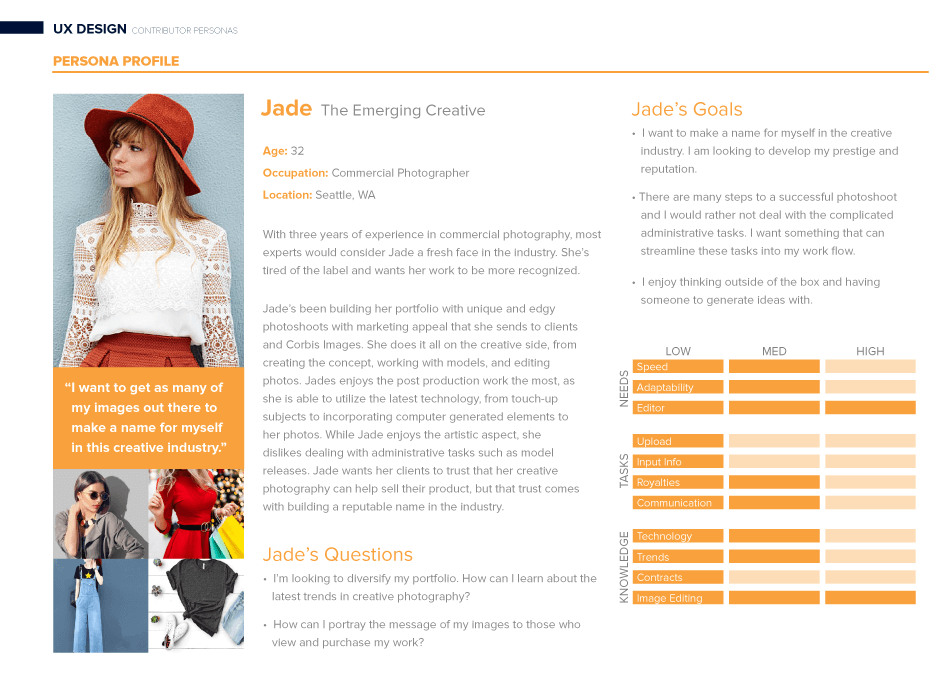
What this does well:
- Gives the persona a theme by having an overall tagline (“The Emerging Creative”).
- Uses data visualization to condense information in easy-to-read ways (by having the low, medium, and high rankings across a number of different areas).
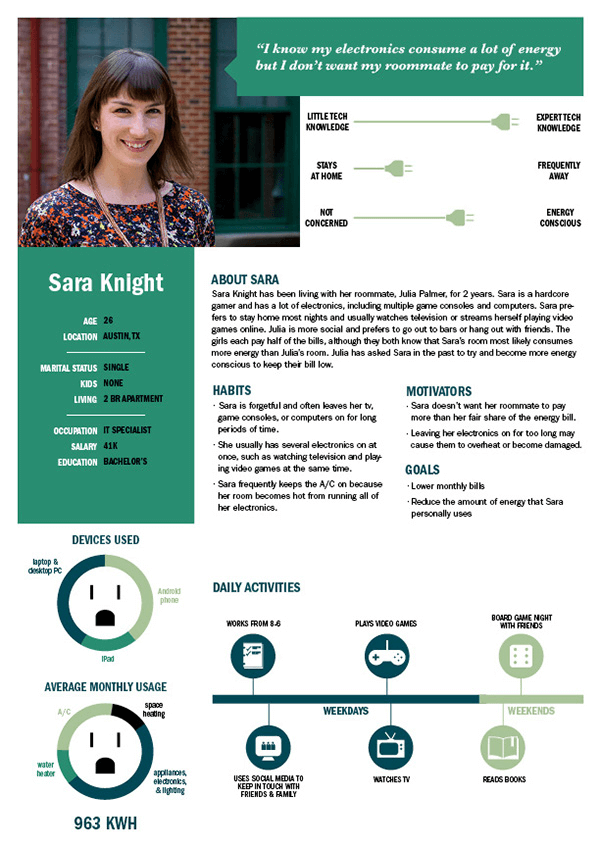
What this does well:
- Illustrates how the user spends their time (by providing a week-in-the-life timeline view).
- Measures industry-specific metrics that’s relevant and useful for the business (such as estimating average monthly electricity use).
How to create personas:
1. Collect information: Start wide and gather as much as you can about your customers. There are many sources of data you can use to help with this exercise:
- Learn from assumptions—Every role in your business interacts with customers in a different way. Your product team understands what features delight users, while your sales team knows what specific problems they’re trying to solve. Everyone likely has a set of assumptions (or better yet, hard facts) around who your users are. This is invaluable in that it allows you to learn from multiple perspectives.
- Web analytics—What you’re tracking on your site or social channels is a goldmine for user data. There are many behaviors you can distill from seeing click rates, conversion rates, bounce rates, and so on. For instance, a pattern of users leaving your site commonly after visiting your checkout page is a clear indicator of friction in the purchase process.
- Firsthand research—Go straight to the source and talk to them! Conducting user interviews to test out the usability of a product/service is the most direct way of knowing your users. Another way of doing this is to conduct focus groups.
- Ask for feedback—If low on resources and time, you could also send surveys (such as customer satisfaction surveys) to get a pulse on how your users feel about you at the end of a customer support exchange.
It can be easy to forget these follow-up steps. That’s why having a virtual communications tool that can, say, automate the process of sending surveys at the end of a customer exchange can make life that much easier.
- CRM tool—Let’s not forget that your CRM tool is another goldmine for user data. This is true if you’ve got a communication platform (like RingCentral) that supports popular customer service software (like Salesforce and Zoho). Imagine having every interaction (happening by video, phone, chats, or text) from any team (sales, marketing and support) logged so that they can be analyzed later:
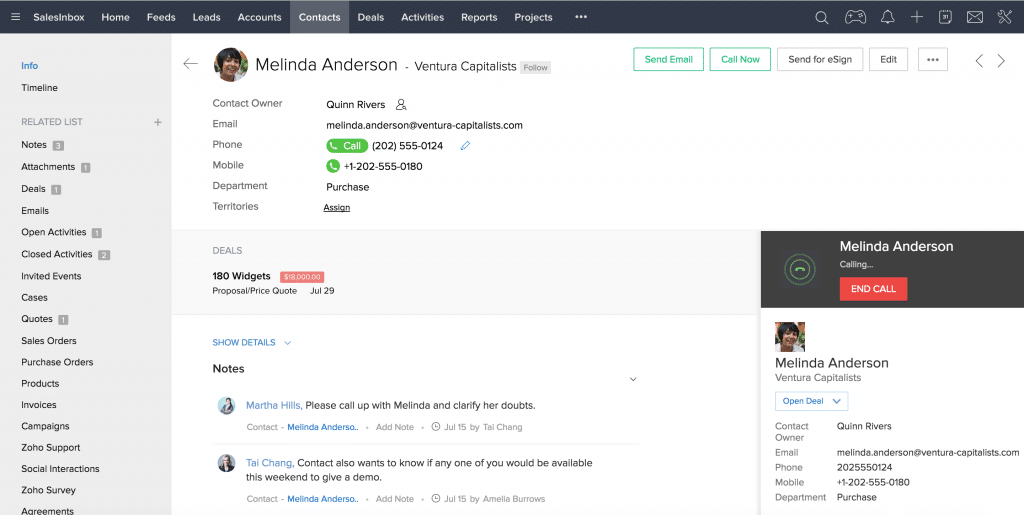
2. Segment your users: Now that we’ve gone wide, let’s distill it all down and recap what we’ve learned. At the end of this, you should have three to five types of customers that represent that majority of who you serve. Congratulations, you’ve just discovered your core set of personas.
3. Build your template: This is all about defining the metrics you want to consistently track across each and representing them in clear ways. The examples above should give you a good idea of key information you should include, but as mentioned, you should tailor personas to fit your business.
Because personas are meant to inform decisions over time, you should invest to make sure they’re functional and practical to use. In other words—pay attention to design! Make it visual and, please, stay away from building personas in a Word document! Even without a designer, there are online tools like Uxpressia2 that can help you craft visually engaging personas.
- Input and update: With the template and metrics nailed down, put on your creative hat and start writing. Taking all the information you’ve previously gathered and segmented, bring your users to life by giving them backstories, goals, and personalities. Try to keep your personas as distinct as possible, as in, eliminate big overlaps (the Resourceful Mother and the Adventurous Bachelor shouldn’t both have the same views when it comes to managing money). And remember, personas are a tool that will continuously be used and updated, so treat this process as more of a cycle to keep coming back to as you regularly learn more about your customers.
Step 2: Build a customer journey map template
As mentioned, the tactical tool for organizing this information in a visual way is called the customer journey map.
Remember those four stages of the customer journey (Awareness, Explore, Purchase, Retention) we touched on earlier? Great, because to start our template we’re going to need to come back to them.
Similar to persona building, journey mapping is all about understanding the mindset and experiences of your customers by putting yourself in their shoes and imagining what the process of engaging with you looks like.
To do this, you’ll need to come up with ways to organize all of this information.
During each phase, common ways to think about the customer’s experience is to explore:
- Actions: What specific steps are they taking? Who are they speaking to? What are they seeing, hearing, feeling?
- Motivations: How are their needs being met in the current phase? What needs to happen to motivate them to enter the next phase?
- Pain points: What uncertainties are preventing them to enter the next phase? Are there barriers to their understanding, ease, and comfort?
- Feelings: What frustrations do they face? What moments delight them? What are they responding well to? What moments stand out for the good or bad?
There are different ways you can structure your customer journey map, some with more detail than others, but at the very minimum, your map should outline the set of actions users are taking across the phases and look something like this:
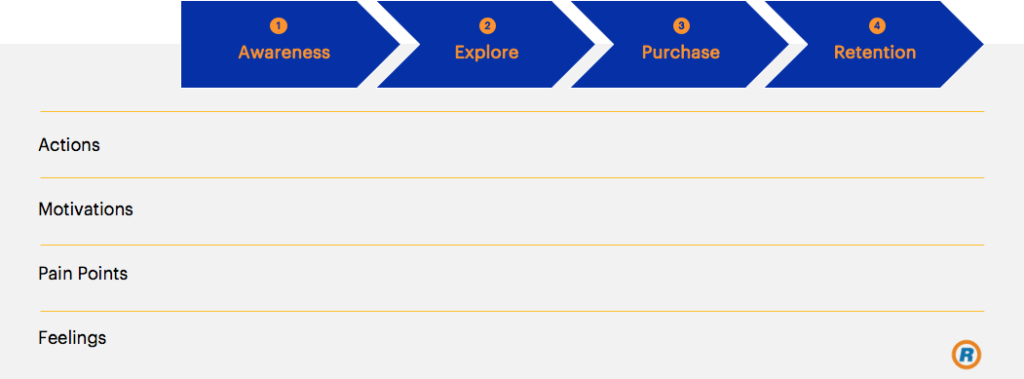
To keep building on your map, you can include all the different touchpoints that you share with your customers.
Touchpoints are all the points of contact where you provide a service, process a transaction, or simply exchange information with a customer. These can be during a customer support interaction, at the checkout line, when someone comes across your Facebook ad, and so on.
At every touchpoint, there’s also a channel that the exchange happens though, these can be:
- In-person and in-store
- Phone calls and web calls
- Video calls and screen shares
- Text/SMS
- Live chat and chatbots
- Mobile apps
- Social media and posts
- Surveys
The idea is that the customer journey map should help you understand your customer’s experience at each touchpoint across multiple channels.
Here are some examples of templates that combine these elements in different visual ways:
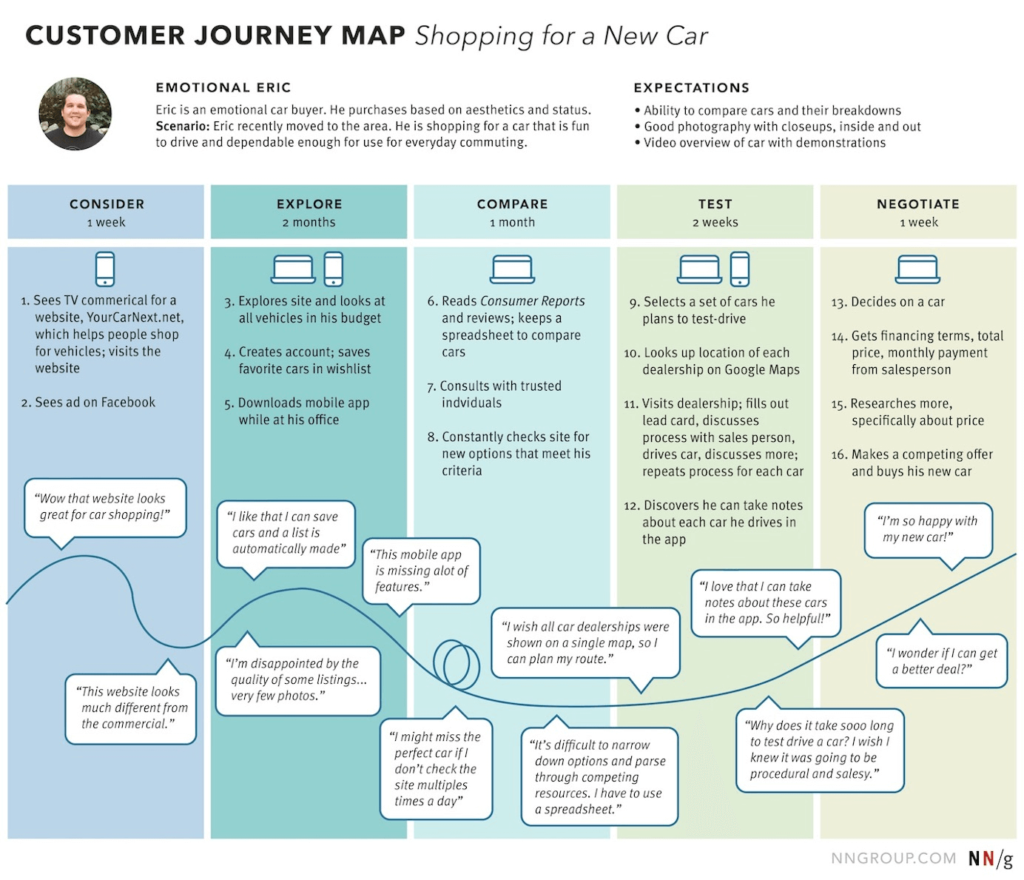
What this does well:
- Provides a direct quote to summarize the experience and emotions of the customer.
- Includes the length of time someone might spend in each phase.
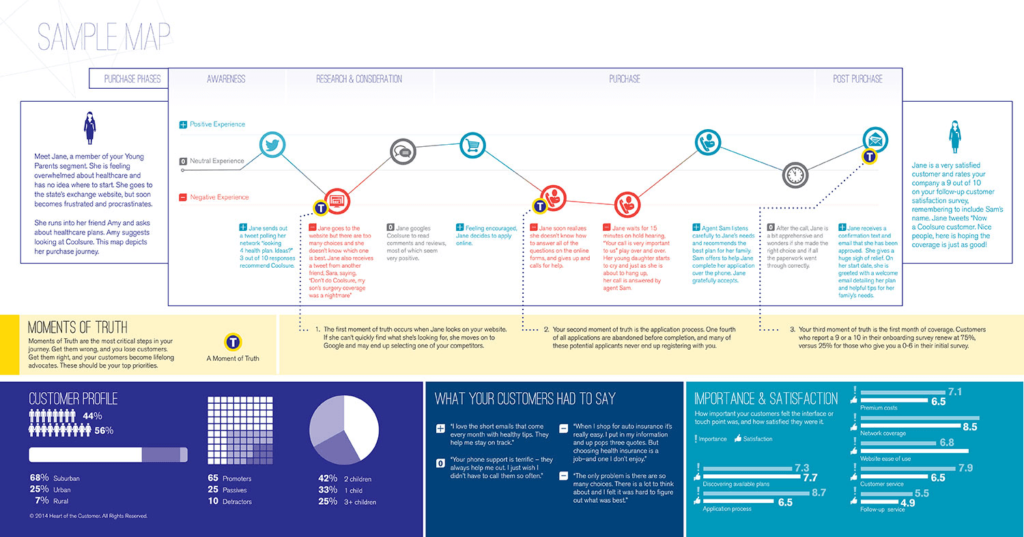
What this does well:
- Has a short description of the persona and gives a story of what she embarks on.
- Includes “Moments of Truth,” which from an optimization perspective (more on this below!), identifies key business opportunities.
Step 3: Build your customer journeys
With the template ready to go, this is where things get interesting. Using your personas, you’re going to build out standard customer journeys. These are “standard” because the goal isn’t to capture the journey of every single customer. Like personas, customer journeys are more generalized and represent the actions of an aggregate group of users who share a common theme.
There are two ways you can do this:
1, Create separate maps for each persona
Advantage: For journeys that describe a complex series of activities, keeping each persona separate is just much cleaner overall to manage from a visual and functional perspective. For personas with very distinct and different goals, it just might not make sense to note the similarities and meeting points between them. Plus, you don’t need to worry about fitting everything onto a neat page and packing it with more information than it can fit. Most importantly, this will let you focus on creating a strong, detailed narrative for each persona.
2. Create a single map for multiple personas
Advantage: These journeys illustrate how the separate experiences of two personas can merge at the same point. Why is this useful? Because at the same moment in time, two people will have two very different sets of expectations—while one person feels delighted by the abundance of choice online, another might feel discouraged. Having more perspectives like this allows you to make more informed decisions overall on how to better serve all your customers, not just a subset.
Here’s an example of what a multi-persona map might look like:
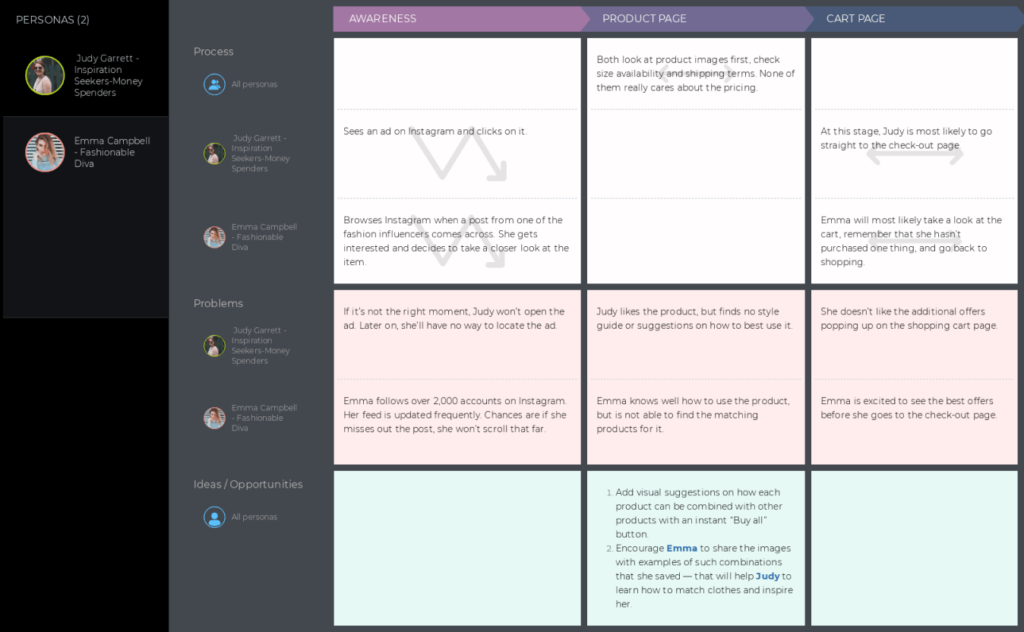
Once you decide on which approach works best for you, refer back to all the customer information you gathered during the persona development stage to begin filling in your map.
All the same rules apply, by the way.
That is, keep it neat, well designed, and simple to understand.
A well-developed customer journey map has the right level of detail that paints a complete picture of one’s entire experience, yet simple enough for anyone in your business to pick up and follow along. Basically, it should be able to live as a standalone, self-explanatory tool that doesn’t need context or notes to be understood.
For teams unfamiliar or don’t have the resources to design something custom, Uxpressia3 also provides an online tool for creating customer journey maps, with the ability to collaborate, gather analytics, and attach files.
Step 4: Optimize the customer journey
Working with your customer journey is a journey in itself. With your customer journey map on hand, look through and see what the cumulative end-to-end effect you’re leaving on your customer is. Though their intent and goals will shift as they move through the phases, you’ll want to make sure that their experience feels consistent.
What does a consistent experience look like? For customers, it’s being treated as though the business is familiar with you after even just the first point of contact.
No matter how a customer comes into contact with you (in-person or online) you want to ensure they’re receiving the same level of consistent support and that they can pick up where they left off without being treated like a new customer each time.
Creating an omnichannel customer experience
Businesses that deliver fragmented experiences have a much harder time retaining customers. In fact, those with weak omnichannel customer service retain only 33% of their customers, while those with robust omnichannel strategies retain on average 89% of their customers.4
But let’s back up a bit and explain what an omnichannel experience looks like and how customer journeys help with building one. Consider all the channels where touchpoints happen in this customer journey, for instance:
- A couple needs to get a mortgage.
- They do a quick search online to see what their options are and read through the sites of a few reputable companies (Channel: website).
- After browsing different offerings, they choose one company to go with and fill out a form to speak with an agent for more help.
- The agent greets them by name when they pick up (Channel: phone) and verifies that the information they shared is still accurate.
- After the call, the agent sends them an email (Channel: email) summarizing the recommendations they talked about. In the email, there’s also a set of credentials for the couple to log in to an online portal for more information.
- Upon login (Channel: online portal), the couple sees their personal information has already been filled out and their mortgage has been pre-approved.
- A day later, they get a text (Channel: mobile) to check the portal for their welcome package. The process is complete, and they’re set to move into their new home.
- Pleased by how easy the process was and noticing a referral link, they share the link with their friends who are looking for mortgages as well.
You probably have had similar experiences of connecting with businesses through multiple channels over the course of your engagement. By now, this is a pretty standard practice. Businesses are reaching prospects and customers by adopting channels that they’re used to using (like sometimes choosing to text them instead of emailing—did you know that 98% of messages sent by text are opened compared to only 20% when sent by email?).5
In doing so, communication stays regular and consistent. This is why it’s so important to have a multi-channel communication platform (like RingCentral!)—it allows you to connect with your customers in ways most convenient to them while also allowing you to capture insights through all those channels.
During these communications, businesses need to make sure that they know their customers—not in a “we’re collecting all your information and Big-Brothering you” way, but in a way where you remember to give them a small gift on their birthday for instance, or where you automatically fill out information in forms so that it’s more convenient for them like in the mortgage example above.
This is what delivering an omnichannel experience means, and understanding the customer journey can help you create these experiences because it helps bridge gaps in the process. For instance, in the above, by learning that customers regularly want to speak to an agent by phone during the Explore process, you can add an automated appointment scheduling tool to reduce the friction for them to move into the Purchase phase.
By understanding how customers interact with your brand across multiple channels, you can optimize your journey to alleviate their frustrations, pain points, and help nudge them along in their journey.
Get started on your next customer journey(s)
There’s no single way to create a purposeful journey. A lot of this will come down to what customer data you currently have, as well as what resources or tools you plan on adopting to gain those insights. What we will say though is that the combination of a strong CRM and communications tool goes a long way to building end-to-end journeys that accurately reflect how your customers are behaving and what they’re experiencing.
The value of customer journeys is that they act as mirrors to reflect what is and isn’t working with your current products or services, implementation techniques, costs, and/or operations. Understanding this data allows you to make improvements in a more targeted, intentional way rather than through blind trial and error.
At the end of the day, the key to unlocking this value is to stay on top of updating your journey as your business continues to evolve and your customers’ needs change over time—which of course means regularly.
1 business.linkedin.com/marketing-solutions/blog/sales-and-marketing/2018/customer-journey-map-definition-benefits-examples
2, 3 uxpressia.com/personas-online-tool
4 behaviouralresponse.com/customer-journey-optimization
5 campaignmonitor.com/blog/email-marketing/2019/01/roi-showdown-sms-marketing-vs-email-marketing
Updated Mar 13, 2025











